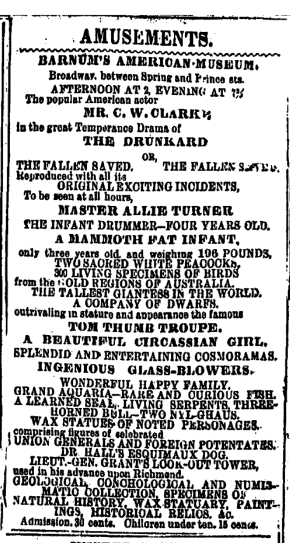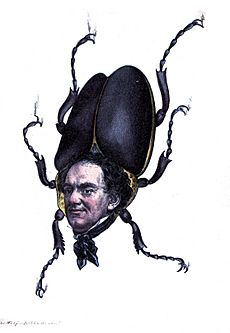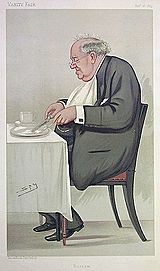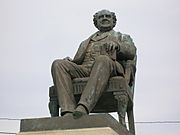P. T. Barnum facts for kids
Quick facts for kids
P. T. Barnum
|
|
|---|---|
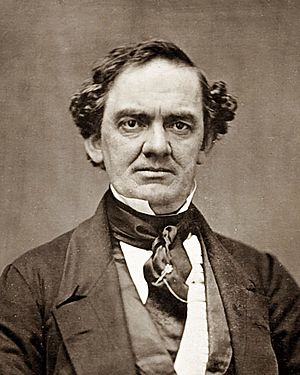
Barnum in 1851
|
|
| Mayor of Bridgeport, Connecticut | |
| In office 1875–1876 |
|
| Member of the Connecticut House of Representatives from the Fairfield district |
|
| In office 1866–1869 |
|
| Personal details | |
| Born |
Phineas Taylor Barnum
July 5, 1810 Bethel, Connecticut, U.S. |
| Died | April 7, 1891 (aged 80) Bridgeport, Connecticut, U.S. |
| Resting place | Mountain Grove Cemetery, Bridgeport |
| Political party | Democratic (until 1854) Republican (after 1854) |
| Spouses |
Charity Hallett
(m. 1829; died 1873)Nancy Fish
(m. 1874) |
| Children | 4 |
| Occupation |
|
| Known for | Founding the Barnum & Bailey Circus |
| Signature | |
Phineas Taylor Barnum (July 5, 1810 – April 7, 1891) was a famous American showman, businessman, and politician. He is best known for creating the Barnum & Bailey Circus with James Anthony Bailey. Barnum was also an author, publisher, and helped many charities. He once said, "I am a showman by profession."
Barnum started as a small business owner in his early twenties. He even began a weekly newspaper. In 1834, he moved to New York City and began his career in entertainment. He first had a group called "Barnum's Grand Scientific and Musical Theater." Soon after, he bought a museum called Scudder's American Museum and renamed it Barnum's American Museum.
He used his museum to show off interesting things, including some clever tricks. Two of his most famous attractions were the Fiji mermaid and General Tom Thumb. In 1850, he brought the famous Swedish opera singer Jenny Lind to America for a tour. He paid her a huge amount of money for her performances.
Barnum faced financial problems in the 1850s because of bad investments. However, he overcame these difficulties by giving lectures. He also served two terms in the Connecticut legislature starting in 1865. Later, in 1875, he became the mayor of Bridgeport, Connecticut. There, he worked to improve the city's water supply and add gas streetlights. He also helped start Bridgeport Hospital in 1878.
His most lasting fame came from the circus business, which he started when he was 60 years old. In 1870, he created "P. T. Barnum's Grand Traveling Museum, Menagerie, Caravan & Hippodrome." This was a traveling circus, animal show, and museum of unique people. It became known by many names over the years.
Barnum was married to Charity Hallett from 1829 until she passed away in 1873. They had four children together. In 1874, he married Nancy Fish, who was a friend's daughter. They remained married until Barnum died in 1891 from a stroke. He was buried in Mountain Grove Cemetery, Bridgeport, a place he helped design.
Contents
Early Life and First Shows
Phineas Taylor Barnum was born in Bethel, Connecticut. His father, Philo Barnum, was an innkeeper and tailor. His grandfather, Phineas Taylor, was a lawmaker and landowner who greatly influenced him.
Barnum tried several businesses, including a general store and selling books. In 1829, he started a newspaper called The Herald of Freedom. He sometimes wrote strong opinions in his paper. In 1834, he sold his store.
He began his career as a showman in 1835. He bought and exhibited a woman named Joice Heth. She was presented as George Washington's former nurse and claimed to be 161 years old. Barnum used this attraction to draw large crowds.
Becoming a Showman

Barnum had some ups and downs with his first entertainment group. In 1841, he bought Scudder's American Museum in New York City. He made many improvements to the building and added new exhibits. He then renamed it "Barnum's American Museum." It quickly became a very popular place.
He added a bright lighthouse lamp and flags to the building to attract attention. The roof was turned into a garden where people could enjoy views of the city. He even offered daily hot-air balloon rides. Inside, he featured live acts and interesting displays. These included albinos, giants, little people, jugglers, and magicians. There were also detailed models of cities and a collection of animals.
Famous Attractions: Fiji Mermaid and Tom Thumb
In 1842, Barnum showed off his first big "hoax," or clever trick. It was a creature with the body of a monkey and the tail of a fish, called the "Feejee" mermaid. He said these hoaxes were just ways to get people interested in the museum. He believed in "first attracting and then pleasing them."
After the mermaid, he introduced Charles Stratton, a little person known as "General Tom Thumb." Charles was only four years old but was said to be 11. He was very talented and learned to imitate famous people like Hercules and Napoleon.
In 1843, Barnum hired fu-Hum-Me, a Native American dancer. From 1844 to 1845, he toured Europe with General Tom Thumb. They even met Queen Victoria, which was a huge publicity success. This opened doors for them to visit other royal families, including the Tsar of Russia. Barnum bought more museums during this time, including the nation's first major museum, Rembrandt Peale's Museum in Philadelphia. By late 1846, Barnum's Museum was attracting 400,000 visitors each year.
Bringing Jenny Lind to America
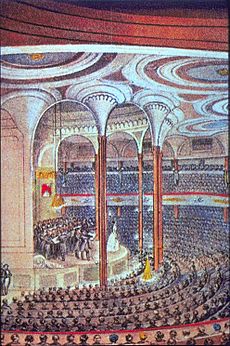
Barnum learned about the famous singer Jenny Lind, known as the "Swedish Nightingale," during his European tour. Even though he had never heard her sing, he offered her a huge sum of money to perform in America. He agreed to pay her $1,000 a night for 150 nights, covering all her expenses. Barnum was sure he could use Lind's good reputation to promote her tour.
Lind asked for the money upfront, and Barnum agreed. This allowed her to raise money for charities, especially for schools for poor children in Sweden. Barnum had to borrow a lot of money to pay her. He even convinced a minister that Lind would be good for American morals, and the minister lent him the last $6,000.
Lind arrived in America in September 1850. She was already a celebrity because of Barnum's months of advertising. About 40,000 people greeted her at the docks. The press was there, and "Jenny Lind items" were sold everywhere. When Lind saw how much money Barnum was making, she asked for a new agreement. This new deal gave her her original fee plus most of the concert profits after Barnum's management fee. She wanted to earn as much as possible for her charities.
The tour began on September 11, 1850, at Castle Garden. It was a huge success, earning Barnum four times his investment. People were so excited that the newspapers called it "Lind mania." Barnum sometimes sold tickets by auction, which Lind didn't like. She convinced him to make many tickets available at lower prices.
Barnum's advertising always went ahead of Lind, building excitement. He even had many journalists working for him. After New York, the tour continued along the East Coast, then through the Southern states and Cuba. By early 1851, Lind felt uncomfortable with Barnum's constant marketing. She decided to end her agreement with him. They parted ways as friends. Lind continued her tour for almost another year on her own. She gave 93 concerts for Barnum, earning about $350,000, while Barnum made at least $500,000.
New Entertainment and Challenges
Barnum wanted to change how people viewed theaters. He wanted them to be seen as places of learning and fun for families. He built New York City's largest theater and called it the "Moral Lecture Room." He hoped this name would attract families and get approval from moral leaders. He started with a play about avoiding alcohol. Then he showed other plays, even simpler versions of Shakespeare, to make them family-friendly.
He also organized flower shows, beauty contests, and pet shows. Baby contests, like for the fattest baby or the cutest twins, were very popular. In 1853, he started a picture newspaper called Illustrated News. A year later, he finished his autobiography, which sold over a million copies.
In the early 1850s, Barnum invested in developing East Bridgeport, Connecticut. He lent a lot of money to a clock company to move there. But the company went bankrupt by 1856, and Barnum lost all his money. This led to four years of legal problems and public embarrassment. However, Tom Thumb offered to help, and they went on another European tour. Barnum also started giving lectures, often about avoiding alcohol. By 1860, he was out of debt and got his museum back.

Barnum then created America's first aquarium and expanded his museum's wax figure section. His museum grew to four buildings. In 1860, he brought the Siamese Twins Chang and Eng out of retirement to perform. He also introduced William Henry Johnson, a little person who spoke a mysterious language Barnum created. In 1862, he found giantess Anna Swan and Commodore Nutt, a new Tom Thumb. Barnum even visited President Abraham Lincoln at the White House with Commodore Nutt.
During the Civil War, his museum attracted many people looking for a distraction. He added exhibits and plays that supported the Union side. In 1864, a fire, possibly started by someone who supported the Confederacy, burned Barnum's American Museum to the ground. Barnum rebuilt it in another location, but that one also burned down in 1868. The second loss was too much, and Barnum stopped being in the museum business.
The Circus King
Barnum didn't start his circus business until he was 60 years old. In 1870, he created "P. T. Barnum's Grand Traveling Museum, Menagerie, Caravan & Hippodrome" in Delavan, Wisconsin. This was a traveling circus, animal show, and museum of unique acts. It changed names several times. In 1881, it merged with James Bailey and James L. Hutchinson. It became known as "Barnum & Bailey's." This circus was the first to have three rings.
The show's main attraction was Jumbo, a huge African elephant Barnum bought in 1882 from the London Zoo. The Barnum and Bailey Circus also had acrobats and unique performers. Barnum kept growing the circus despite fires and train accidents. He was helped by skilled circus professionals who managed the daily shows. He and Bailey separated in 1885 but reunited in 1888. Their show, "Barnum & Bailey Greatest Show On Earth," later toured the world.
Barnum was one of the first circus owners to move his circus by train. This was a very smart idea because there weren't many paved roads in America then. Using trains allowed Barnum to reach many more places. In this new business, Barnum listened to the advice of his younger partners.
Barnum became known as the "Shakespeare of Advertising" because of his new and impressive ideas.
Author and Truth-Teller
Barnum wrote several books, including Life of P. T. Barnum (1855) and The Humbugs of the World (1865). He also wrote Struggles and Triumphs (1869) and The Art of Money-Getting (1880).
Barnum was often called the "Prince of Humbugs." He believed it was fine for entertainers to use clever tricks in their advertising. He felt this was okay as long as the audience felt they got their money's worth. However, he disliked people who cheated others through fraud. He spoke out against "spirit photographers" who claimed to talk to the dead. In his book The Humbugs of the World, he offered money to any medium who could prove they could communicate with the dead.
Barnum's Role in Politics
Barnum was very involved in politics. He focused on issues like race and slavery before the American Civil War. He was against the Kansas–Nebraska Act of 1854, which supported slavery. Because of this, he left the Democratic Party and joined the new anti-slavery Republican Party.
Barnum said that "politics were always distasteful to me." However, he was elected to the Connecticut legislature in 1865. He served four terms as a Republican representative for Fairfield. He spoke strongly in favor of the Thirteenth Amendment to the United States Constitution, which ended slavery. He said that every human soul is important, no matter their background.
Barnum was elected for four more sessions. In 1875, he became mayor of Bridgeport, Connecticut. As mayor, he worked to improve the city's water supply and add gas lighting to the streets. He also helped start Bridgeport Hospital in 1878 and was its first president.
Giving Back to the Community
Barnum enjoyed what he called "profitable philanthropy." He believed that if he could improve his city and help his neighbors while also making a profit, it would encourage more good deeds. He was appointed to the board of trustees for Tufts University before it was even founded. He gave a large gift of $50,000 in 1883 to create a museum there. This museum later became known as the Barnum Museum of Natural History. Tufts University made Jumbo the elephant its mascot, and its students are called "Jumbos."
Personal Life and Death
On November 8, 1829, Barnum married Charity Hallett. They had four children: Caroline, Helen, Frances, and Pauline. His wife Charity passed away on November 19, 1873. The following year, he married Nancy Fish, who was the daughter of a close friend. Nancy was 40 years younger than Barnum.
Barnum died from a stroke at his home in 1891 when he was 80 years old. He is buried in Mountain Grove Cemetery, Bridgeport, Connecticut. He actually helped design this cemetery himself.
Barnum's Legacy
Barnum built four large homes in Bridgeport, Connecticut. One of the most famous was Iranistan, built in 1848. It had a unique design with domes and spires, inspired by a building in England. Sadly, it burned down in 1857.
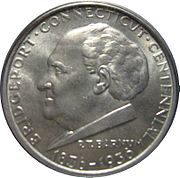
When Barnum died, people praised him for his good deeds. They called him a symbol of the American spirit and cleverness. He even asked a newspaper to print his obituary (a notice of his death) before he died so he could read it. On April 7, 1891, just hours before he passed away, Barnum asked about the circus ticket sales for the day.
In 1893, his former partners placed a statue in his honor at Seaside Park in Bridgeport. Barnum had given the land for this park in 1865. His circus was sold to Ringling Brothers in 1907. The Ringling Brothers and Barnum & Bailey circuses ran separately until they joined together in 1919. This created the famous Ringling Bros. and Barnum & Bailey Circus.
The United States Mint even made a special coin in 1936 for Bridgeport's 100th anniversary. It featured Barnum's picture on one side. A cartoonist named Walt Kelly grew up in Bridgeport and named a character after Barnum in his Pogo comic strip. For many years, an annual Barnum Festival was held in Bridgeport to honor him. In 2010, a life-sized statue of Barnum was placed outside the public library in his hometown of Bethel.
Barnum also helped start the Bridgeport & Port Jefferson Steamboat Company in 1883. This company still operates ferries across the Long Island Sound. One of their boats is even named the M.V. PT Barnum. The Barnum Museum in Bridgeport keeps many of Barnum's interesting items and curiosities.
See also
 In Spanish: P. T. Barnum para niños
In Spanish: P. T. Barnum para niños
- Barnum effect
- Barnum's Aquarial Gardens, Boston, Massachusetts (1862–1863)
- Cardiff Giant
- Carl Hagenbeck
- Colonel Routh Goshen
- Fedor Jeftichew
- Human zoo
- Isaac W. Sprague
- Jenny Lind private railroad car
- Lucia Zarate
- Nellie Keeler
- The Greatest Show on Earth, 1952 film
- Wild Men of Borneo
- Zip the Pinhead


